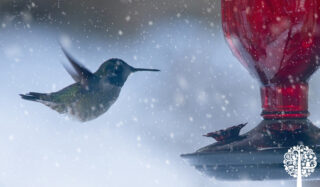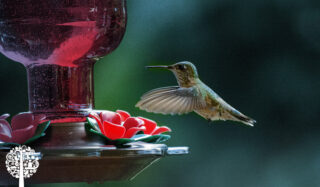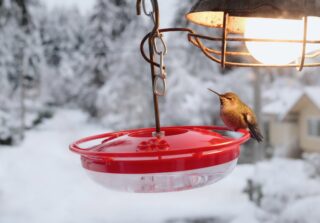Between March and September, hummingbirds are spotted in gardens across North America, enjoying the nectar from brightly-colored plants. As part of the garden’s ecosystem, hummingbirds are excellent pollinators and fun to watch! As they fly between blossoms, their tiny wings gyrate at incredible speeds.
As autumn comes and gardens die back, many varieties migrate south, seeking warmer climates and food. The Anna’s hummingbird is a notable exception, and although rare, the Rufous hummingbird can sometimes be spotted in colder climates during winter.

Hummingbirds are vulnerable to frostbite, hypothermia, or hypoglycemia (from insufficient calories), so nectar feeders are a prime food source for these little birds.
Here are some tips on how to care for your feeder and keep these much-needed pollinators safe this winter.
Accessibility
Place the feeder in an accessible location that allows the birds easy access from all sides and offers a sense of security; under the eaves and away from any windows is ideal. In addition, this placement creates a warming zone for the feeder by keeping it dry and sheltered from wind and snow.

Hummingbirds naturally attract red and bright colors, indicating nectar-rich flowers and why many feeders have a red base or red container. If your feeder isn’t red, you can still jazz it up by tying on some red ribbon or wrapping it in red twinkle lights. It’s essential, especially in extreme cold, that birds can find it.
Feeder Type
Garden centers, big box stores, and nature and wildlife stores sell hummingbird feeders. Shallow dish feeders are better than tall tube feeders, especially in winter, as they are easier to thaw if the nectar freezes. Avoid hummingbird feeders that have exposed metal parts –they can become too cold in extreme temperatures and harmful to the birds.
Keep It Clean
Feeders often attract large numbers of hummingbirds to one area, so any fungus or bacteria in the feeder will affect many birds. Feeders should be taken down and cleaned about once a week with a solution of one part vinegar to four parts water.
Don’t Let It Freeze
Ensure the feeding tube entrances never freeze and your nectar is continually free of ice crystals. In frigid weather, bring the feeder in at night but remember to put it back out first thing in the morning. Hummingbirds are early risers, so the sooner the feeder gets put back out in the morning, the better.

A great way to keep the nectar and feeder warm is to wrap it in a sock filled with rice and place it next to an outdoor light source. Hummingbird feeder rain covers and heat lights are available online or in pet supply stores.
Nectar
A good rule of thumb is to replace the feeder’s nectar every three to five days. This prevents bacteria and keeps the food supply fresh. Although you can buy premixed store nectar, making the syrup yourself is easy. Make a big batch and store it in the fridge for up to ten days:
- boil water for two minutes
- mix one-part white sugar with four parts water
Ensure the mixture has cooled before filling the feeder, and never use honey, sweeteners, molasses, brown or raw sugar as a substitute. White sugar is the closest to sugars in nature.
Never change the ratio of water to sugar, and don’t add red food coloring to the nectar to attract the birds. The dye will upset their delicate metabolisms.
Remember, keeping these little birds fed and warm during winter helps them and the entire garden!